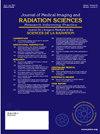Multimodal SVM Classification for Early-stage Alzheimer's Disease Diagnosis Using T1-weighted MR and F-18 FDG PET Imaging
IF 1.3
Q3 RADIOLOGY, NUCLEAR MEDICINE & MEDICAL IMAGING
Journal of Medical Imaging and Radiation Sciences
Pub Date : 2024-10-01
DOI:10.1016/j.jmir.2024.101539
引用次数: 0
Abstract
Alzheimer's disease is a significant global health challenge characterized by progressive brain degeneration associated with aging. Early detection is crucial for improved prognosis and treatment outcomes. Our study aimed to develop a support vector machine (SVM) classification model using T1-weighted MR and F-18 FDG PET brain imaging to classify cognitive normal (CN) and early-stage Alzheimer's disease, including early mild cognitive impairment (EMCI) and late mild cognitive impairment (LMCI), in individuals aged 65-75. The study comprised three steps. Firstly, image preprocessing involved uniformity processing, B1 bias field correction for MR images, and FWHM optimization with spatial/intensity normalization for PET images. Secondly, MR images were registered to the MNI305 brain template for structural segmentation, and PET images were normalized using the standardized PET template. Co-registration of normalized PET images to segmented MR images provided anatomical segmented PET uptake volumes. These served as input for the classification model. Thirdly, SVM models classified CN vs. LMCI, EMCI vs. LMCI, and CN vs. EMCI using MRI, PET, and combined PET/MR. Feature sets included all features, clinical-based features, and F1-score ranked features, resulting in 27 classification models. In CN vs. EMCI, combined PET/MR with all features achieved 0.71 AUC, 65.78% accuracy, and 68.67% specificity. For CN vs. LMCI, superior performance was observed with combined PET/MR using F1-score ranked features: 0.82 AUC, 77.78% accuracy, and 77.55% specificity. In EMCI vs. LMCI, PET alone with all features achieved the highest performance: 0.72 AUC, 69.23% accuracy, and 60.32% specificity. In conclusion, PET is pivotal in MCI stage differentiation, and using all features aids in challenging tasks (CN vs. EMCI and EMCI vs. LMCI). The combined PET/MR modality notably distinguishes CN from MCI, emphasizing the potential of multimodal imaging to enhance differentiating cognitive states in individuals.
利用 T1 加权 MR 和 F-18 FDG PET 成像对早期阿尔茨海默病诊断进行多模态 SVM 分类
阿尔茨海默氏症是全球健康面临的重大挑战,其特征是与衰老相关的渐进性脑退化。早期发现对于改善预后和治疗效果至关重要。我们的研究旨在开发一种支持向量机(SVM)分类模型,利用 T1 加权 MR 和 F-18 FDG PET 脑成像技术对 65-75 岁人群的认知正常(CN)和早期阿尔茨海默病(包括早期轻度认知障碍(EMCI)和晚期轻度认知障碍(LMCI))进行分类。研究包括三个步骤。首先,图像预处理包括均匀性处理、MR 图像的 B1 偏置场校正以及 PET 图像的 FWHM 优化和空间/强度归一化。其次,将 MR 图像注册到 MNI305 脑模板上进行结构分割,并使用标准化 PET 模板对 PET 图像进行归一化处理。将归一化后的 PET 图像与分割后的 MR 图像共同配准,可提供解剖学分割的 PET 摄取量。这些都是分类模型的输入。第三,SVM 模型使用 MRI、PET 和 PET/MR 组合对 CN 与 LMCI、EMCI 与 LMCI 和 CN 与 EMCI 进行分类。特征集包括所有特征、基于临床的特征和 F1 分数排序特征,共产生了 27 个分类模型。在 CN vs. EMCI 中,结合所有特征的 PET/MR 获得了 0.71 的 AUC、65.78% 的准确率和 68.67% 的特异性。在 CN 与 LMCI 的对比中,使用 F1 分数排序特征的联合 PET/MR 观察到了更优越的性能:AUC 为 0.82,准确率为 77.78%,特异性为 77.55%。在 EMCI 与 LMCI 的对比中,仅 PET 使用所有特征的性能最高:AUC 为 0.72,准确率为 69.23%,特异性为 60.32%。总之,正电子发射计算机断层显像在 MCI 分期中至关重要,使用所有特征有助于完成具有挑战性的任务(CN vs. EMCI 和 EMCI vs. LMCI)。正电子发射计算机/核磁共振成像相结合的模式可显著区分 CN 和 MCI,强调了多模态成像在增强区分个体认知状态方面的潜力。
本文章由计算机程序翻译,如有差异,请以英文原文为准。
求助全文
约1分钟内获得全文
求助全文
来源期刊

Journal of Medical Imaging and Radiation Sciences
RADIOLOGY, NUCLEAR MEDICINE & MEDICAL IMAGING-
CiteScore
2.30
自引率
11.10%
发文量
231
审稿时长
53 days
期刊介绍:
Journal of Medical Imaging and Radiation Sciences is the official peer-reviewed journal of the Canadian Association of Medical Radiation Technologists. This journal is published four times a year and is circulated to approximately 11,000 medical radiation technologists, libraries and radiology departments throughout Canada, the United States and overseas. The Journal publishes articles on recent research, new technology and techniques, professional practices, technologists viewpoints as well as relevant book reviews.
 求助内容:
求助内容: 应助结果提醒方式:
应助结果提醒方式:


